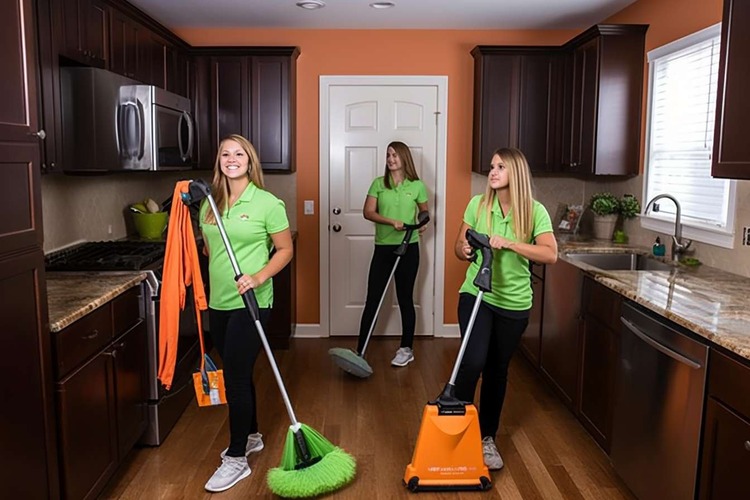Cleaning Services That Shine: A Practical Guide
Keeping homes and workplaces clean is more than a matter of looks—it supports comfort, productivity, and wellbeing. Whether you’re balancing a busy schedule or managing a facility, professional cleaning services can save time and deliver consistent results. This guide explains what cleaning companies typically offer, how to choose the right service in your area, ways to ensure quality and safety, and how to prepare your space for a smooth, efficient visit.

What professional cleaning includes
Most cleaning companies provide two main tiers: standard cleaning and deep cleaning. Standard cleaning usually covers dusting and wiping surfaces, vacuuming and mopping floors, cleaning kitchen counters and sinks, wiping appliance exteriors, and sanitizing bathroom fixtures. Deep cleaning goes further—think baseboards, door frames, grout detail, inside oven and refrigerator, cabinet interiors, vents, and hard-to-reach areas. Many teams also offer add-ons like window washing, laundry folding, and organizing on request. Clarify what’s included in your plan to avoid surprises and ensure your priorities are addressed.
Residential vs. commercial cleaning
Residential cleaning focuses on homes and apartments, with attention to kitchens, bathrooms, living areas, and bedrooms. Commercial cleaning targets offices, retail spaces, and shared facilities where foot traffic is heavier and surfaces vary (e.g., glass partitions, conference tables, shared kitchens). Commercial jobs may involve after-hours scheduling, trash and recycling protocols, floor care for different materials, and compliance with building policies. If you manage a workplace, ask about experience with your kind of space, frequency options (daily, weekly, or custom schedules), and whether the team brings specialized equipment for larger areas.
Green and allergen-conscious options
If you prefer fewer harsh chemicals or have sensitivities, look for companies that offer eco-friendly or low-VOC products and microfiber-based routines. HEPA-filter vacuums help capture fine particles and allergens, which can be important for households with pets or asthma. Fragrance-free options are often available; request them in advance if scents are a concern. Keep in mind that “green” doesn’t mean less effective—modern formulations can clean and sanitize efficiently when used correctly. For delicate surfaces such as natural stone, brass, or unfinished wood, ask the team to use approved, pH-appropriate cleaners to prevent damage.
How to assess quality and safety
Quality and safety start with clear vetting and training. Ask whether the company conducts background checks and provides ongoing staff training on product use, surface care, and cross-contamination prevention (for example, color-coded cloths for bathrooms versus kitchens). Verify that the company carries liability insurance and, where applicable, workers’ compensation coverage. Consistency matters, so inquire whether the same team or lead will visit regularly and if they use checklists to standardize results. Reviews can be helpful, but also look for responsiveness—how quickly do they answer questions, confirm appointments, or resolve issues?
Scheduling and scope: set clear expectations
The right cadence depends on your lifestyle and space. Many households choose weekly or biweekly standard cleanings, adding a deep clean seasonally or before events. Offices may prefer nightly or several-times-per-week service, with periodic floor care or window cleaning. Before the first visit, share your top priorities: high-traffic areas, pet zones, or rooms that need extra attention. Agree on a scope of work, access instructions, and any off-limits areas. It also helps to estimate time on site so everyone understands how much can be completed in each session. Clear expectations make it easier to maintain consistent results.
Hygiene and cross-contamination best practices
Professional cleaners should follow simple, effective hygiene protocols. These include using fresh cloths and mop heads for each site, separating bathroom tools from kitchen tools, and sanitizing high-touch surfaces like handles, switches, and remotes. Microfiber cloths, when used properly, capture more dust and debris than paper towels and can reduce product use. For workplaces, ask if the team can align with your internal hygiene plan—such as focusing on break rooms, phones, keyboards, and shared touchpoints. Documented procedures minimize risk and help maintain trust across repeated visits.
What supplies and equipment are provided
Some cleaning companies bring everything they need: vacuums, mop systems, cloths, and products. Others may offer a discount if you provide supplies. If you have surface-specific needs—like a hardwood-safe cleaner, stainless steel polish, or stone-safe solutions—share that in advance. For allergy-friendly service, ask for HEPA vacuums and fragrance-free products. In multi-tenant buildings, confirm elevator access, parking, and any restrictions on equipment to avoid delays. A quick supplies checklist before the first appointment reduces interruptions and ensures your team arrives prepared.
Handling special cases: move-outs and post-construction
Move-in/move-out and post-construction cleanings demand more time and detail. The team may need to remove fine dust from vents, lighting fixtures, cabinet interiors, and window tracks. Adhesive residue, paint specks, and protective film on appliances often require careful, non-scratch tools. If you’re preparing a rental for new occupants, align the work with your property’s standards to prevent rework. For newly renovated spaces, allow dust to settle for a short period before scheduling the final clean to avoid a lingering film on surfaces.
Simple prep to get the most value
A bit of preparation maximizes results during the booked time. Consider:
-
Decluttering surfaces so cleaners can focus on cleaning rather than moving items.
-
Securing valuables and labeling any fragile or no-touch areas.
-
Crating or separating pets and sharing any pet-related instructions.
-
Providing entry details, parking notes, and Wi‑Fi access if needed for smart locks.
-
Leaving a brief list of top priorities or areas of concern.
Clear communication and a tidy staging area help the team work efficiently and reduce the risk of missed details.
Sustainability and waste reduction
A thoughtful cleaning routine can support sustainability goals. Reusable microfiber, concentrated products that reduce plastic waste, and proper dilution systems minimize environmental impact. Ask your provider about responsible disposal of empty containers and whether they use refill stations. In offices, coordinate with your waste and recycling program so cleaning teams can help maintain proper sorting. Over time, these small choices add up to a cleaner space and a lighter footprint.
When to reconsider or adjust your plan
If certain areas consistently need more attention, adjust your scope or frequency rather than stretching the same time across a growing to-do list. Seasonal changes, new pets, or a hybrid work schedule may shift your needs. Keep a simple log of recurring issues—such as streaks on glass, missed baseboards, or dust accumulation in vents—and share it during check-ins. Reliable providers welcome feedback and use it to refine checklists, tools, or timing.
In summary, successful cleaning services combine clear expectations, trained professionals, and the right products for your surfaces and sensitivities. By defining scope, confirming safety and hygiene practices, and preparing your space before each visit, you create the conditions for consistent, high-quality results at home or at work.






